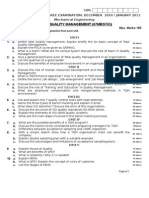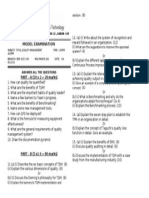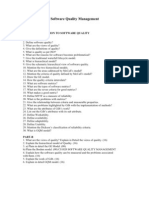Kings: Department of Mechanical Engineering
Kings: Department of Mechanical Engineering
Uploaded by
Rohini DivakaranCopyright:
Available Formats
Kings: Department of Mechanical Engineering
Kings: Department of Mechanical Engineering
Uploaded by
Rohini DivakaranOriginal Title
Copyright
Available Formats
Share this document
Did you find this document useful?
Is this content inappropriate?
Copyright:
Available Formats
Kings: Department of Mechanical Engineering
Kings: Department of Mechanical Engineering
Uploaded by
Rohini DivakaranCopyright:
Available Formats
MG1301 Total Quality Management
KINGS
COLLEGE OF ENGINEERING
DEPARTMENT OF MECHANICAL ENGINEERING
ACADEMIC YEAR 2010-2011 / EVEN SEMESTER
Question Bank
Sub. Code/Name Year/Sem : MG 1301 / Total Quality Management : IV/VII UNIT-I (INTRODUCTION) Part-A (2 Marks) 1. Define quality. 2. Mention any four principles of TQM 3. Define Quality cost. 4. Define strategic planning. 5. What are the steps involved in strategic planning? 6. What are the types of quality statement? 7. Name any two popular awards for quality. 8. What is Quality Council? 9. What do you mean by total cost of quality? 10. Define TQM. Part-B 1. Explain the fourteen steps of Deming's philosophy for improving quality, productivity and competitiveness. (16)
2. What are the customer perceptions of quality? Explain. Explain the service quality with its characteristics and expectations. (16)
3. Explain quality costs. What are the barriers for implementing TQM in an industry? Explain. (16) Kings College of Engineering
MG1301 Total Quality Management 4. Explain the role of senior management. 5. Explain in detail about the process of strategic planning. 6. Discuss in detail about the quality statement.
(16) (16) (16)
UNIT-II (TQM PRINCIPLES) Part-A (2 Marks) 1. Define customer satisfaction. 2. How the customer complaints are collected? 3. Define service quality. 4. Name some customer perception on quality. 5. What is employee motivation? 6. Define Kaizen. 7. List out the 5'S of Japanese methodology with its purpose. 8. Define partnering. 9. Define Empowerment. 10. What do you understand by performance appraisal? What is the use of it? PART B
1. Explain Juran's 'Quality Trilogy' in detail. 2. Explain the following with their advantages and limitations. i. Kaizen ii. PDSA Cycle iii. Performance appraisal 3. Explain the various dimensions involved in quality. 4. Discuss briefly about the various methods used to employee involvement.
(16) (16)
(16) (16)
Kings College of Engineering
MG1301 Total Quality Management 5. Explain in detail about the supplier partnership. 6. What is the basic concept of performance measures? 7. Explain the strategy for implementing performance measures and techniques.
(16) (16) (16)
UNIT-III (STATISTICAL PROCESS CONTROL) Part-A (2 Marks) 1. What do you understand by SPC? 2. List out seven basic management tools of TQM. 3. Define the term process capability. 4. Differentiate between defects and defectives. 5. What is six-sigma? 6. What is a process flow diagram? 7. List out the new seven management tools. 8. Define mean and mode. 9. What is a control chart? What are its uses? 10. What is an Affinity diagram?
PART-B 1. Explain the detail about the 7 SPC tools of quality. 2. Explain the term "process capability". ' 3. Discuss in detail about the concept of Six-Sigma. 4. List out the new 7 management tools and explain each one. 5. Discuss briefly the various tools of statistical fundamentals. (16) (16) (16) (16) (16)
Kings College of Engineering
MG1301 Total Quality Management
Unit-IV (TQM TOOLS) Part-A (2 Marks) 1. Define Benchmarking. 2. What do you understand by QFD? 3. Why TPM is required? Give its types of maintenance. 4. What do you mean by FMEA? Give its types. 5. What is Taguchi's Loss Function concept? 6. List out the various steps involved in a benchmarking process. 7. What do you mean by HOQ? 8. What are the 4 stages of FMEA? 9. Define reliability. 10. What are the responsibilities of a FMEA team.
PART B 1. Explain QFD with a suitable example. What are its advantages and Limitations.(16) 2. Write short notes on: (a) Taguchi's Quality Loss Function (b) FMEA 3. Write short notes on (a) Benchmarking (b) TPM 4. Explain HOQ with the various steps involved to build it. 5. Explain the types of benchmarking and its benefits and pitfalls. 6. Discuss in detail about the FMEA team and FMEA documentation. (16) (16) (16) (16) (16)
Kings College of Engineering
MG1301 Total Quality Management
Unit-V (QUALITY SYSTEM) Part-A (2 Marks) 1. What is ISO? 2. What is the function of ISO 9000? 3. What is Indian Standard quality system? 4. Give the importance of documentation in ISO. 5. Write any 4 steps in implementation of quality system. 6. Define quality audit. 7. What are the objectives of quality audit? 8. What are the benefits of ISO 14000 series of standards 9. List out the stages of an audit. 10. What do you mean by Environmental Policy PART B
1. Explain the steps to be followed in implementing quality system ISO 9001 :2000(16) 2. What are the requirements of ISO 14000? Explain them briefly. 3. Define quality system and explain the evaluation of ISO 9000. 4. Explain ISO 14000 with an Industrial application. (16) (16) (16)
5. Explain the steps followed to get ISO 9000 certification for an educational institute. 6. What are the elements of ISO 9000:2000 quality system? 7. Explain in detail about the quality auditing with its different types. 8. Discuss in briefly about the documentation of quality system. (16) (16) (16)
__________________________
Kings College of Engineering
You might also like
- SQM 16 & 2marks With AnsDocument21 pagesSQM 16 & 2marks With AnsKalyan SundaramNo ratings yet
- Software Quality Assurance Question BankDocument4 pagesSoftware Quality Assurance Question Banksridharanc23No ratings yet
- A.R.Engineering College, Villupuram.: Department of Mechanical EngineeringDocument5 pagesA.R.Engineering College, Villupuram.: Department of Mechanical EngineeringHassan ShathakNo ratings yet
- Toatal Quality ManagementDocument5 pagesToatal Quality ManagementSenthil Kumar GanesanNo ratings yet
- MG 1401 - TQMDocument4 pagesMG 1401 - TQMRameez FaroukNo ratings yet
- Unit 1Document1 pageUnit 1Kanagasabai SabaNo ratings yet
- Uepme71 TQM Q-Bank 2011Document7 pagesUepme71 TQM Q-Bank 2011karthik_1977No ratings yet
- 6th Sem. - MG 1301-TQMDocument5 pages6th Sem. - MG 1301-TQMnarendran2k10No ratings yet
- 2 MarksDocument5 pages2 MarksDeepa SelvamNo ratings yet
- GE2022-Total Quality ManagementDocument5 pagesGE2022-Total Quality ManagementSheena Doria de VeraNo ratings yet
- TQM QBDocument11 pagesTQM QBsrichandranidNo ratings yet
- MG 1301 - TQM - QB - 5 UnitsDocument7 pagesMG 1301 - TQM - QB - 5 UnitsSenthil KumarNo ratings yet
- BA7104 TotalQualityManagementquestionbankDocument10 pagesBA7104 TotalQualityManagementquestionbankAnonymous uHT7dDNo ratings yet
- TQM QBDocument6 pagesTQM QBRsksamyNo ratings yet
- Explain Deming's 14 Points For Improving Quality, Productivity and CompetitivenessDocument10 pagesExplain Deming's 14 Points For Improving Quality, Productivity and CompetitivenessKalyan ChakravarthyNo ratings yet
- Total Quality Management Ge6757 (Analysis From Last 5 Semester Papers) Unit IDocument3 pagesTotal Quality Management Ge6757 (Analysis From Last 5 Semester Papers) Unit ISurya WalkerNo ratings yet
- 8 QM Assignment Unit WiseDocument2 pages8 QM Assignment Unit WiseChhagan kharolNo ratings yet
- Question Bank New As Per GTUDocument3 pagesQuestion Bank New As Per GTUfgyjnsv786No ratings yet
- Improtant Questions of TQMDocument7 pagesImprotant Questions of TQM11priyagargNo ratings yet
- 11150h72 - SQM QBDocument7 pages11150h72 - SQM QBudai21419No ratings yet
- Define Total QualityDocument5 pagesDefine Total QualityAkansha SrivastavaNo ratings yet
- Department of Automobile Engineering: Question Bank Bam8E4-Bme009-Total Quality ManagementDocument5 pagesDepartment of Automobile Engineering: Question Bank Bam8E4-Bme009-Total Quality ManagementLeon MathaiosNo ratings yet
- TQM-important QuestionsDocument5 pagesTQM-important QuestionsSridhar Atla100% (1)
- Ad Hoc and Wireless Sensor Networks Assignment Questions Unit 3 WSN Networking Concepts and Protocol Part ADocument3 pagesAd Hoc and Wireless Sensor Networks Assignment Questions Unit 3 WSN Networking Concepts and Protocol Part ASuguna PriyaNo ratings yet
- TQM Model PaperDocument5 pagesTQM Model PaperEricka ClementsNo ratings yet
- Mechanical Engineering: I. Answer One Full Question From Each UnitDocument1 pageMechanical Engineering: I. Answer One Full Question From Each UnitVitoo OinamNo ratings yet
- PQM 3 Marks Important QPDocument2 pagesPQM 3 Marks Important QPkrishjogdhankar79No ratings yet
- Ge6757 TQM Iq Am2019 RejinpaulDocument1 pageGe6757 TQM Iq Am2019 RejinpaulVicky RahuNo ratings yet
- 058 - GE8077, GE6757 Total Quality Management TQM - Question Bank 2Document19 pages058 - GE8077, GE6757 Total Quality Management TQM - Question Bank 2heba aburayyanNo ratings yet
- Anna University Question Papers and AnswersDocument107 pagesAnna University Question Papers and AnswersSengottuvelu SundaramNo ratings yet
- Me6402 Notes Rejinpaul IIDocument1 pageMe6402 Notes Rejinpaul IIPuneethNo ratings yet
- Qem AssignmentDocument6 pagesQem AssignmentSp PatelNo ratings yet
- Question Bank - Quality Control & AssuranceDocument2 pagesQuestion Bank - Quality Control & AssuranceEr Umesh RohitNo ratings yet
- Ge6757 QB Rejinpaul IIDocument1 pageGe6757 QB Rejinpaul IIsri kishoreNo ratings yet
- Madha Engineering College Department of Aeronautical Engineering/ Eee Ge-8077 - Total Quality Management Important Questions Unit Wise Unit IDocument1 pageMadha Engineering College Department of Aeronautical Engineering/ Eee Ge-8077 - Total Quality Management Important Questions Unit Wise Unit IKishoremcNo ratings yet
- TQM Important Questions UNIT-1Document3 pagesTQM Important Questions UNIT-1Rejin PaulNo ratings yet
- TQM Model Question PaperDocument1 pageTQM Model Question PaperpecmbaNo ratings yet
- TQM 2081 Model ExamDocument1 pageTQM 2081 Model ExamdharaniventhanNo ratings yet
- Mg-1401 Total Quality Management Question PaperDocument2 pagesMg-1401 Total Quality Management Question Papersubhaz100% (6)
- MODELTQMDocument2 pagesMODELTQMNaresh Joseph ChristyNo ratings yet
- Kings: UNIT-1 Part (2 Marks)Document4 pagesKings: UNIT-1 Part (2 Marks)Sai SwethaNo ratings yet
- Total Quality Strategy Question Set FullDocument2 pagesTotal Quality Strategy Question Set FullArunkumar MyakalaNo ratings yet
- Cs1020 Software Quality Management Question Bank: Department of Computer Science and Engineering Question BankDocument6 pagesCs1020 Software Quality Management Question Bank: Department of Computer Science and Engineering Question BankVignesh KumarNo ratings yet
- Anna University - Regulation 2013 GE6757-Total Quality Management 2 Mark Questions Part-A Unit IDocument4 pagesAnna University - Regulation 2013 GE6757-Total Quality Management 2 Mark Questions Part-A Unit IP.ASHOKKUMARNo ratings yet
- TQM SridharDocument2 pagesTQM Sridharanon_716479020No ratings yet
- P16MBA18Document2 pagesP16MBA18Jan kafNo ratings yet
- TQM Model ExamDocument5 pagesTQM Model ExamsaswarajNo ratings yet
- SQM Important QuestionsDocument4 pagesSQM Important QuestionsShankar Prakash GNo ratings yet
- ME 2036 Question BankDocument5 pagesME 2036 Question BankKarthick RamNo ratings yet
- Cs 2055 Software Quality AssuranceDocument3 pagesCs 2055 Software Quality AssuranceAnand KannanNo ratings yet
- Question Bank - SQADocument6 pagesQuestion Bank - SQAsatyamshingade2No ratings yet
- Software Quality Assurance QB PDFDocument4 pagesSoftware Quality Assurance QB PDFnagarajan888No ratings yet
- ST (2 & 16 Mark Question Bank)Document23 pagesST (2 & 16 Mark Question Bank)AnithaNo ratings yet
- Cs 2055 Software Quality AssuranceDocument4 pagesCs 2055 Software Quality AssurancevanitharavichandranNo ratings yet
- TQM QP1Document2 pagesTQM QP1Uma MaheshNo ratings yet
- 16 Marks TQMDocument1 page16 Marks TQMJeyaram KumarNo ratings yet
- Question BankDocument2 pagesQuestion BankSandra StephenNo ratings yet
- Ge6757 TQM Int 2 Q OnlyDocument3 pagesGe6757 TQM Int 2 Q OnlyPushpavalli MohanNo ratings yet
- Cracking the Case of ISO 9001:2015 for Service: A Simple Guide to Implementing Quality Management in Service OrganizationsFrom EverandCracking the Case of ISO 9001:2015 for Service: A Simple Guide to Implementing Quality Management in Service OrganizationsNo ratings yet
- Cracking the Case of ISO 9001:2015 for Manufacturing: A Simple Guide to Implementing Quality Management in ManufacturingFrom EverandCracking the Case of ISO 9001:2015 for Manufacturing: A Simple Guide to Implementing Quality Management in ManufacturingNo ratings yet
- DIET Is A Software ForDocument1 pageDIET Is A Software ForRohini DivakaranNo ratings yet
- Smartwatches Apple Inc. Fitness Tracking Ios Hermès Iphone Iphone 5 Ios 8.2 Wi-Fi Bluetooth Tim CookDocument1 pageSmartwatches Apple Inc. Fitness Tracking Ios Hermès Iphone Iphone 5 Ios 8.2 Wi-Fi Bluetooth Tim CookRohini DivakaranNo ratings yet
- Disneyland Park: Disneyland Resort Disneyland (Disambiguation)Document2 pagesDisneyland Park: Disneyland Resort Disneyland (Disambiguation)Rohini DivakaranNo ratings yet
- Android (Stylized As Android) Is ADocument1 pageAndroid (Stylized As Android) Is ARohini DivakaranNo ratings yet
- Deep-Sea Gigantism: Photic Zone Bars Food Floating Down Abyssal Hadal Celsius BarsDocument2 pagesDeep-Sea Gigantism: Photic Zone Bars Food Floating Down Abyssal Hadal Celsius BarsRohini DivakaranNo ratings yet
































































